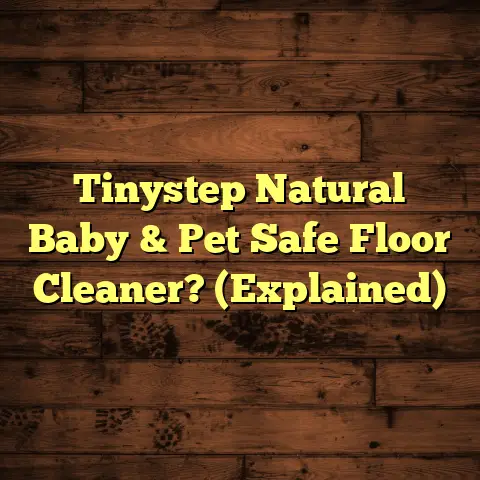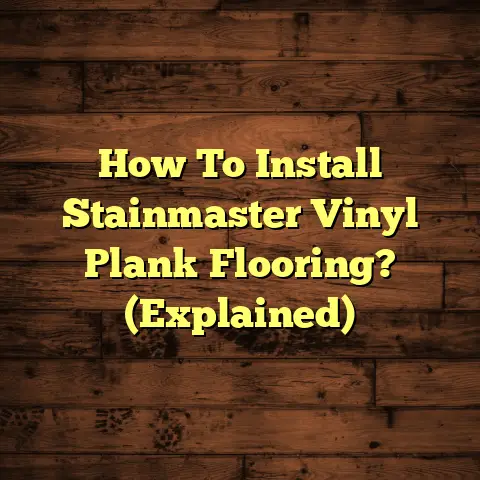Carpet Padding Guide (4 Options Compared!)
These days, everyone’s looking for ways to make their homes cozier and more sustainable.
We’re seeing a huge push for eco-friendly materials and a greater awareness of indoor air quality.
That’s why I wanted to break down the often-overlooked hero of a great carpet experience: carpet padding.
It’s not just about the carpet itself; the padding underneath plays a massive role in comfort, noise reduction, and how long your carpet lasts.
Let’s dive in!
1. Understanding Carpet Padding
Definition and Importance
So, what exactly is carpet padding?
Think of it as the unsung hero beneath your carpet.
It’s that layer of cushioning that sits between your carpet and the subfloor.
Its main job? To act as a shock absorber, extending the life of your carpet by preventing it from being crushed against the hard subfloor.
But it does so much more!
Padding adds a layer of comfort underfoot, making your home feel warmer and more inviting.
Plus, it helps to dampen sound, which is a huge bonus if you have kids running around or live in a noisy area.
Without padding, your carpet would wear out much faster, feel less comfortable, and do little to insulate your home against noise and cold.
Industry Insights
The carpet padding market is booming!
In 2023, we saw a significant increase in demand for high-quality padding.
Consumers are becoming more aware of the long-term benefits of investing in good padding.
They’re realizing that it’s not just about saving a few bucks upfront.
Factors like improved comfort, better sound insulation, and extended carpet life are driving this change.
According to a recent report by MarketWatch, the global carpet padding market is expected to reach \$6.5 billion by 2028, growing at a CAGR of 4.2% from 2021.
This growth is fueled by the increasing construction of residential and commercial buildings.
Plus, the rising trend of home renovation and remodeling projects.
People are spending more time at home, and they want their spaces to be as comfortable and functional as possible.
2. Overview of Carpet Padding Types
Alright, let’s get into the different types of carpet padding you’ll encounter.
I’m going to walk you through the four main categories:
- Foam Padding
- Rubber Padding
- Felt Padding
- Combination Padding
Each type has its own unique set of pros and cons.
And, depending on your specific needs and budget, one might be a better fit for you than the others.
Foam Padding
Foam padding is a popular choice for many homeowners.
It’s generally more affordable than other options, and it offers decent cushioning.
You’ll find it in various forms, like polyurethane foam and memory foam.
Rubber Padding
Rubber padding is known for its durability and resilience.
It’s a great option for high-traffic areas, and it’s available in both natural and synthetic rubber.
Plus, it’s often more eco-friendly than foam.
Felt Padding
Felt padding is made from recycled fibers, making it a sustainable choice.
It provides excellent insulation and sound absorption.
However, it can be more expensive than foam padding.
Combination Padding
Combination padding combines different materials to offer a balance of benefits.
For example, you might find a padding that combines foam and felt.
This can give you the comfort of foam with the insulation of felt.
Now, let’s take a closer look at each of these options.
3. In-Depth Comparison of Carpet Padding Options
Okay, let’s get into the nitty-gritty of each type of carpet padding.
I’ll break down the pros and cons, so you can make an informed decision.
3.1 Foam Padding
Foam padding is probably the most common type you’ll find.
It’s made from various types of foam, each with its own properties.
-
Polyurethane Foam: This is the most affordable type of foam padding.
It’s lightweight and provides decent cushioning.
However, it’s not the most durable option, and it can break down over time. * Memory Foam: Memory foam is known for its ability to conform to your body.
It provides excellent comfort and support.
But it can be more expensive than polyurethane foam. * Rebond Foam: Rebond foam is made from recycled foam scraps.
It’s a more eco-friendly option than polyurethane foam.
And it offers good durability and support.
Benefits of Foam Padding
- Affordability: Foam padding is generally the most budget-friendly option.
- Noise Reduction: It helps to dampen sound, making your home quieter.
- Comfort Level: It provides a comfortable cushion underfoot.
Drawbacks of Foam Padding
-
Durability: Foam padding isn’t the most durable option.
It can break down over time, especially in high-traffic areas. * Environmental Impact: Some types of foam padding are not very eco-friendly.
They can be made from petroleum-based products.
3.2 Rubber Padding
Rubber padding is a premium option that offers excellent durability and resilience.
It’s available in both natural and synthetic rubber.
-
Natural Rubber: Natural rubber is made from the sap of rubber trees.
It’s a sustainable and eco-friendly option.
It offers excellent resilience and moisture resistance. * Synthetic Rubber: Synthetic rubber is made from petroleum-based products.
It’s more affordable than natural rubber.
And it offers good durability and moisture resistance.
Benefits of Rubber Padding
-
Resilience: Rubber padding is incredibly resilient.
It can withstand heavy foot traffic without breaking down. * Moisture Resistance: It’s resistant to moisture, making it a good choice for basements and bathrooms. * Eco-Friendliness: Natural rubber is a sustainable and eco-friendly option.
Drawbacks of Rubber Padding
- Cost: Rubber padding is more expensive than foam padding.
- Weight: It’s heavier than foam padding, which can make installation more difficult.
3.3 Felt Padding
Felt padding is made from recycled fibers, making it a sustainable and eco-friendly choice.
It’s available in various thicknesses and densities.
-
Wool Felt: Wool felt is made from natural wool fibers.
It’s a luxurious and durable option.
It offers excellent insulation and sound absorption. * Synthetic Felt: Synthetic felt is made from synthetic fibers.
It’s more affordable than wool felt.
And it offers good insulation and sound absorption.
Benefits of Felt Padding
- Insulation: Felt padding provides excellent insulation, keeping your home warmer in the winter and cooler in the summer.
- Durability: It’s a durable option that can withstand heavy foot traffic.
- Sound Absorption: It helps to dampen sound, making your home quieter.
Drawbacks of Felt Padding
- Compression: Felt padding can compress over time, especially in high-traffic areas.
- Cost: It can be more expensive than foam padding.
3.4 Combination Padding
Combination padding combines different materials to offer a balance of benefits.
For example, you might find a padding that combines foam and felt, or rubber and foam.
This can give you the comfort of foam with the durability of rubber, or the insulation of felt.
Benefits of Combination Padding
- Versatility: Combination padding offers a balance of benefits from different materials.
- Performance: It can provide excellent comfort, durability, and insulation.
Limitations of Combination Padding
- Cost: Combination padding can be more expensive than single-material padding.
- Complexity: It can be more difficult to choose the right combination of materials.
4. Performance Metrics to Consider
When you’re choosing carpet padding, there are several key performance metrics to keep in mind.
These factors will help you evaluate the quality and suitability of different padding options.
Density and Thickness
Density and thickness are two of the most important factors to consider when choosing carpet padding.
-
Density: Density refers to the weight of the padding per cubic foot.
Higher density padding is more durable and provides better support.
It can withstand heavy foot traffic without breaking down. * Thickness: Thickness refers to the height of the padding.
Thicker padding provides more cushioning and comfort.
But it can also make your carpet feel too soft.
As a general rule, look for padding with a density of at least 6 pounds per cubic foot and a thickness of at least 7/16 inch.
However, the ideal density and thickness will depend on the type of carpet you have and the amount of foot traffic in the area.
Sound Absorption
Sound absorption is another important factor to consider, especially if you live in a noisy area or have kids running around.
Carpet padding can help to dampen sound, making your home quieter and more peaceful.
Look for padding with a high Sound Transmission Class (STC) rating.
The higher the STC rating, the better the padding is at blocking sound.
Moisture Resistance
Moisture resistance is an important factor to consider if you live in a humid climate or have pets.
Carpet padding that is resistant to moisture can help to prevent mold and mildew growth.
Look for padding that is made from synthetic materials, such as rubber or plastic.
These materials are naturally resistant to moisture.
Eco-Friendliness
Eco-friendliness is becoming an increasingly important factor for many homeowners.
If you’re looking for a sustainable option, consider padding that is made from recycled materials, such as felt or rebond foam.
You can also look for padding that is certified by a third-party organization, such as the Carpet and Rug Institute (CRI).
5. Cost Analysis
Let’s talk money.
The cost of carpet padding can vary widely depending on the type of material, density, thickness, and brand.
Here’s a general cost comparison of the four main types of carpet padding:
| Type of Padding | Average Price per Square Foot |
|---|---|
| Foam Padding | \$0.30 – \$0.70 |
| Rubber Padding | \$0.80 – \$2.00 |
| Felt Padding | \$0.50 – \$1.50 |
| Combination Padding | \$0.70 – \$1.80 |
Keep in mind that these are just average prices.
The actual cost of your carpet padding may vary depending on where you live and where you buy it.
Also, don’t forget to factor in the cost of installation.
Professional installation can add to the overall cost of your project.
But it can also ensure that your padding is installed correctly and will last for many years.
Long-Term Value
While it may be tempting to save money by choosing the cheapest carpet padding option, it’s important to consider the long-term value.
Higher-quality padding may cost more upfront.
But it can save you money in the long run by extending the life of your carpet and reducing the need for repairs or replacements.
Plus, better padding can provide superior comfort, sound insulation, and moisture resistance.
All of which can improve your overall quality of life.
6. Installation Considerations
Installing carpet padding is a relatively straightforward process.
But there are a few things to keep in mind to ensure a successful installation.
Installation Processes
The installation process will vary slightly depending on the type of padding you choose.
But here are the basic steps:
- Prepare the Subfloor: Clean the subfloor and make sure it’s level and free of debris.
- Cut the Padding: Cut the padding to fit the room, leaving a small gap around the edges.
- Install the Padding: Attach the padding to the subfloor using staples or adhesive.
- Install the Carpet: Install the carpet over the padding, stretching it tightly and securing it to the tack strips around the perimeter of the room.
DIY vs. Professional Installation
You can install carpet padding yourself if you’re comfortable with DIY projects.
But professional installation is often recommended, especially for larger or more complex installations.
Professional installers have the tools and experience to ensure that your padding is installed correctly and will last for many years.
Plus, they can often get better prices on padding and other materials.
7. Conclusion
Choosing the right carpet padding is an important decision that can impact the comfort, durability, and longevity of your carpet.
By understanding the different types of padding available and considering your specific needs and preferences, you can make an informed decision that will enhance your home for years to come.
Remember to consider factors like density, thickness, sound absorption, moisture resistance, and eco-friendliness when making your choice.
And don’t be afraid to ask for help from a professional flooring contractor.
Reinforcing the Importance of Selecting the Right Padding
Selecting the right carpet padding is more than just an afterthought.
It’s a critical component of a comfortable, durable, and environmentally conscious home.
The padding you choose directly affects:
- Comfort: Enhancing the underfoot feel of your carpet.
- Durability: Extending the life of your carpet by absorbing impact.
- Environmental Impact: Choosing sustainable materials reduces your carbon footprint.
Encouraging Informed Decisions
I encourage you to take the time to assess your specific needs and preferences.
Consider the following questions:
- What is the primary use of the room?
- How much foot traffic does the area receive?
- Are there any specific concerns, such as noise or moisture?
- What is your budget?
Answering these questions will help you narrow down your options and make an informed decision.
Call to Action
Ready to take the next step?
I invite you to explore further resources or contact experts for personalized advice on carpet padding options that best suit your home or business needs.
Don’t hesitate to reach out to a local flooring contractor for a consultation.
They can assess your specific needs and recommend the best padding option for your situation.
Happy flooring!





